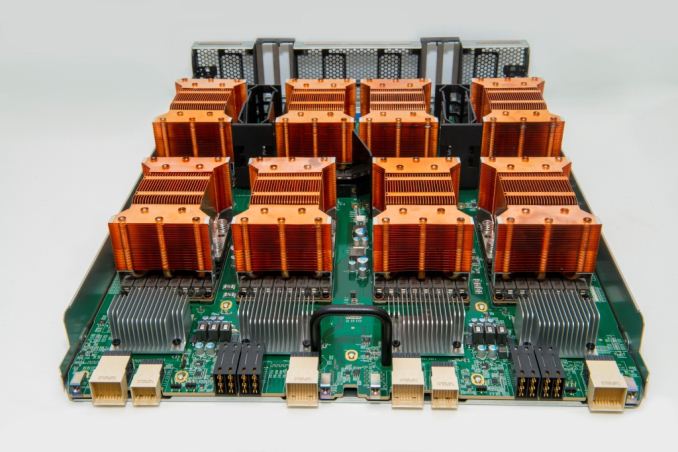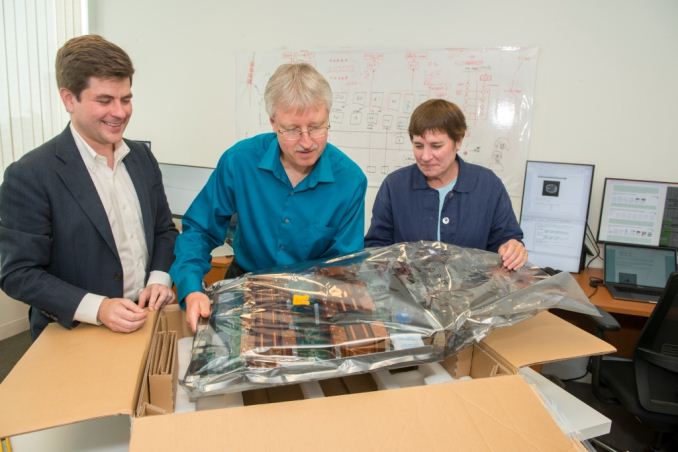NVIDIA Ships First Volta-based DGX Systems
by Nate Oh on September 7, 2017 10:00 AM EST- Posted in
- GPUs
- Tesla
- NVIDIA
- Volta
- Machine Learning
- GV100
- Deep Learning

This Wednesday, NVIDIA has announced that they have shipped their first commercial Volta-based DGX-1 system to the MGH & BWH Center for Clinical Data Science (CCDS), a Massachusetts-based research group focusing on AI and machine learning applications in healthcare. In a sense, this serves as a generational upgrade as CCDS was one of the first research institutions to receive a Pascal-based first generation DGX-1 last December. In addition, NVIDIA is shipping a DGX Station to CCDS later this month.
At CCDS, these AI supercomputers will continue to be used in training deep neural networks for the purpose of evaluating medical images and scans, using Massachusetts General Hospital’s collection of phenotypic, genetics, and imaging data. In turn, this can assist doctors and medical practitioners in making faster and more accurate diagnoses and treatment plans.
First announced at GTC 2017, the DGX-1V server is powered by 8 Tesla V100s and priced at $149,000. The original iteration of the DGX-1 was priced at $129,000 with a 2P 16-core Haswell-EP configuration, but has since been updated to the same 20-core Broadwell-EP CPUs found in the DGX-1V, allowing for easy P100 to V100 drop-in upgrades. As for the DGX Station, this was also unveiled at GTC 2017, and is essentially a full tower workstation 1P version of the DGX-1 with 4 Tesla V100s. This water cooled DGX Station is priced at $69,000.
| Selected NVIDIA DGX Systems Specifications | ||||||
| DGX-1 (Volta) |
DGX-1 (Pascal) |
DGX-1 (Pascal, Original) |
DGX Station | |||
| GPU Configuration | 8x Tesla V100 | 8x Tesla P100 | 4x Tesla V100 | |||
| GPU FP16 Compute | General Purpose | 240 TFLOPS | 170 TFLOPS | 120 TFLOPS |
||
| Deep Learning | 960 TFLOPS | 480 TFLOPS | ||||
| CPU Configuration | 2x Intel Xeon E5-2698 v4 (20-core, Broadwell-EP) |
2x Intel Xeon E5-2698 v3 (16 core, Haswell-EP) |
1x Intel Xeon E5-2698 v4 (20-core, Broadwell-EP) |
|||
| System Memory | 512 GB DDR4-2133 (LRDIMM) |
256 GB DDR4 (LRDIMM) |
||||
| Total GPU Memory | 128 GB HBM2 (8x 16GB) |
64 GB HBM2 (4x 16GB) |
||||
| Storage | 4x 1.92 TB SSD RAID 0 | OS: 1x 1.92 TB SSD Data: 3x 1.92 TB SSD RAID 0 |
||||
| Networking | Dual 10GbE 4 InfiniBand EDR |
Dual 10Gb LAN | ||||
| Max Power | 3200W | 1500W | ||||
| Dimensions | 866mm x 444mm x 131mm (3U Rackmount) |
518mm x 256mm x 639mm (Tower) |
||||
| Other Features | Ubuntu Linux Host OS DGX Software Stack (see Datasheet) |
Ubuntu Desktop Linux OS DGX Software Stack (see Datasheet) 3x DisplayPort |
||||
| Price | $149,000 | Varies | $129,000 | $69,000 | ||
Taking a step back, this is a continuation of NVIDIA’s rollout of Volta-based professional/server products, with DGX Volta meeting its Q3 launch date, and OEM Volta targeted at Q4. In the past months, the first Tesla V100 GPU accelerators were given out to researchers at the 2017 Conference on Computer Vision and Pattern Recognition (CVPR) in July, while a PCIe version of the Tesla V100 was formally announced during ISC 2017 in June.
Source: NVIDIA











48 Comments
View All Comments
Drumsticks - Thursday, September 7, 2017 - link
Of course. Will be looking forward to any future coverage y'all have for us on Volta :)Yojimbo - Thursday, September 7, 2017 - link
Yeah, and from their own benchmarks, that 4x performance boost translates to only a less than 2x boost in actual deep learning workloads. In one benchmark, NVIDIA claims the DGX-1V trains about 2.4 times faster than the DGX-1P. Based on core count and clock differences, using standard FP16 instructions the expectation would be about 1.5 times faster. So, assuming there isn't any reduction in bandwidth bottlenecks with the V100, the Tensor cores seem to be providing about a 1.6 times speed up over standard FP16 instructions in practical use.colonelclaw - Thursday, September 7, 2017 - link
What does this mean for the eventual release of consumer-focussed Volta-based GeForce products? Can we expect GeForce 11 cards before Xmas 2017, or is it more likely to be some time in 2018?A5 - Thursday, September 7, 2017 - link
Doubtful. V100 isn't a consumer product, even if V102 is probably largely similar. I suspect they'll sell all of these that they can make for the next few months.Taiki - Thursday, September 7, 2017 - link
The DGX-1 (Pascal) was released 2 months before consumer GPU but looking at the lack of rumours (testings boards...), I'm not really expecting anything before CES 2018.Moreover, the GTX 1180/2080 will ship with the GV104, which is a different die than the V100/V102, so the timing between them doesn't have to be correlated.
limitedaccess - Thursday, September 7, 2017 - link
Memory contract prices and available volume makes it unlikely for a release (at least any with meaningful supply) in 2017. 2018Q1 is the likely candidate for consumer releases barring any issues.Nate Oh - Thursday, September 7, 2017 - link
During NV's latest earnings call, JHH stated: "Volta for gaming, we haven't announced anything [...] But for the holiday season for the foreseeable future, I think Pascal is just unbeatable."[1][2] In his words, Volta-based GeForce products are not expected in 2017. Like others mentioned, V100 timeline doesn't necessarily mean anything much with respect to consumer Volta products.[1] https://www.pcgamer.com/nvidias-next-gen-volta-gam...
[2] https://seekingalpha.com/article/4097782-nvidia-nv...
Santoval - Friday, September 8, 2017 - link
They are not rushing with gaming Volta boards because Vega performed much worse than expected. If Vega 64 had beat 1080Ti gaming Volta samples would probably have already be sent to reviewers.jordanclock - Friday, September 8, 2017 - link
I think you're really underestimating the turnaround on next GPU generations.Yojimbo - Friday, September 8, 2017 - link
Look at the turnaround from the P100 to the V100. And the V100 is a more complex and much bigger chip than the consumer GPUs will be. NVIDIA could have brought consumer Volta in 2017 if they wanted to.And they possibly could have a couple revisions of the chip floating around at various stages in the pipeline and when they decide when they want to bring it to market they choose an appropriate revision to mass produce.